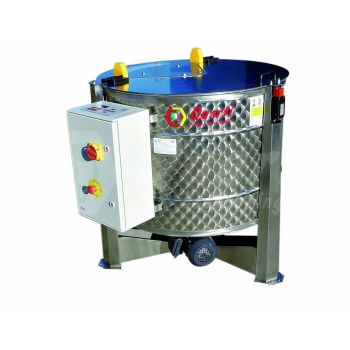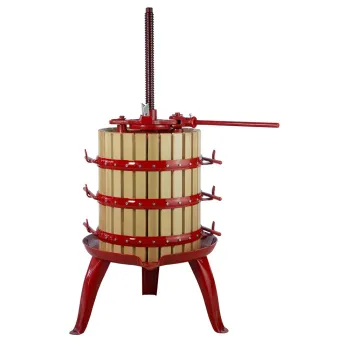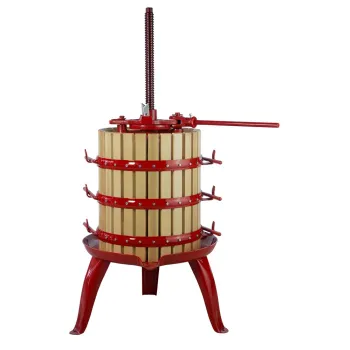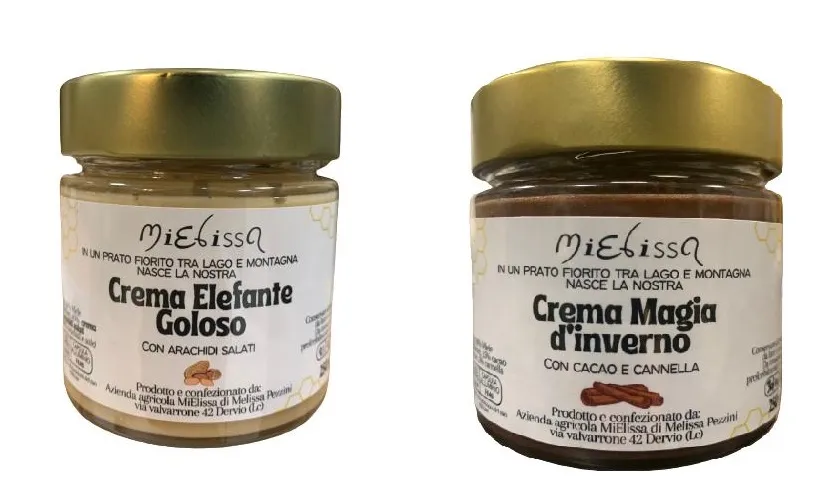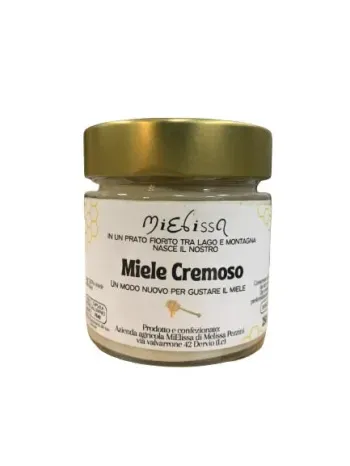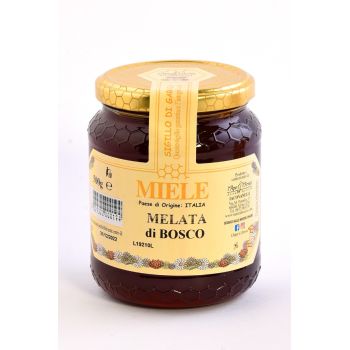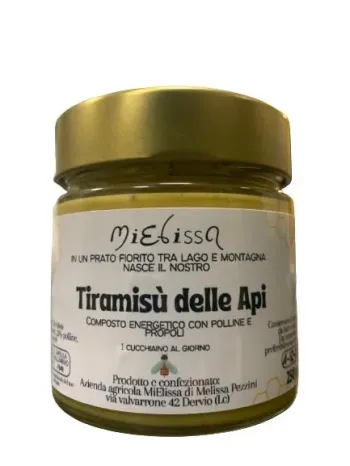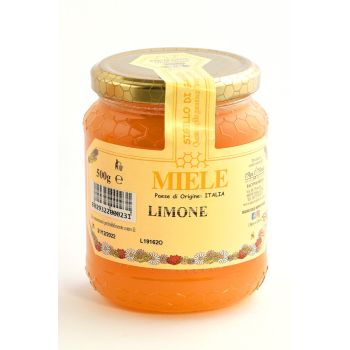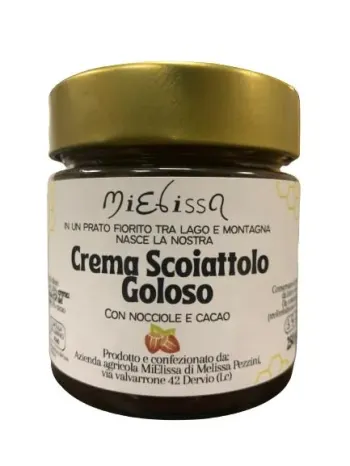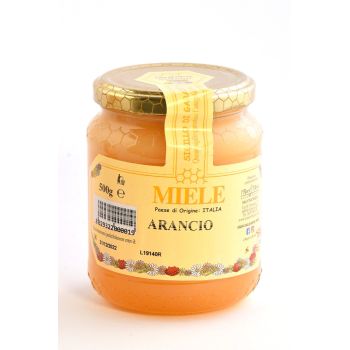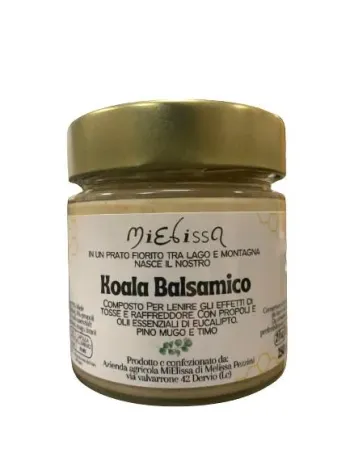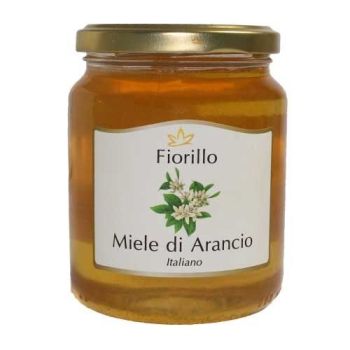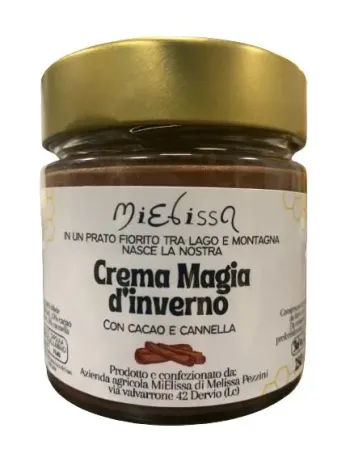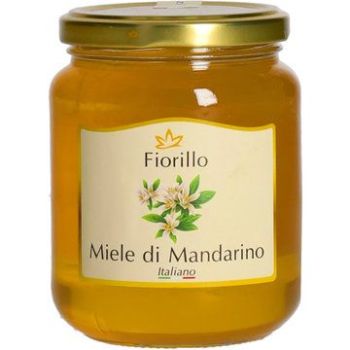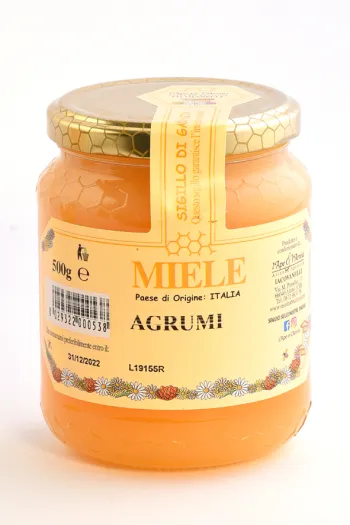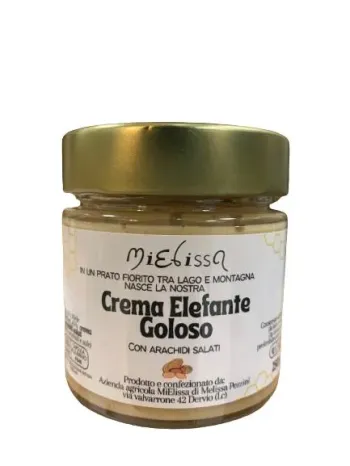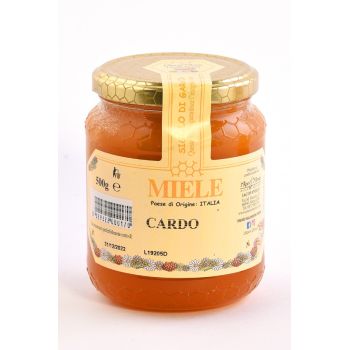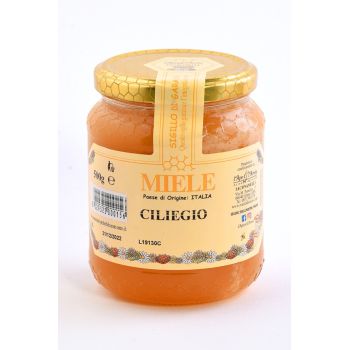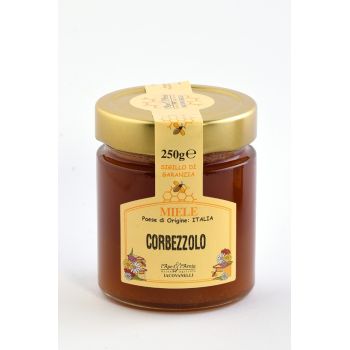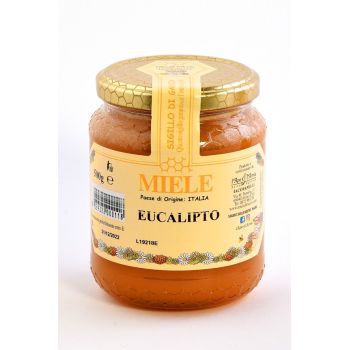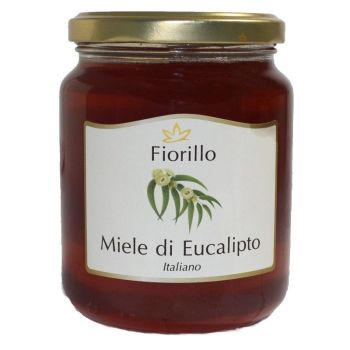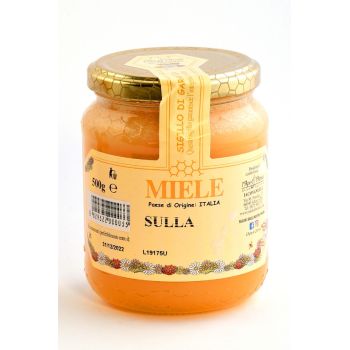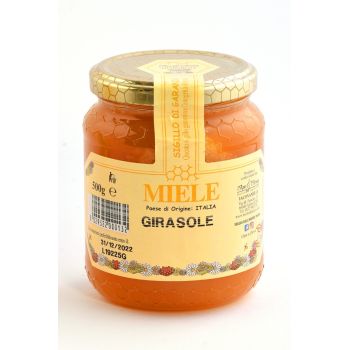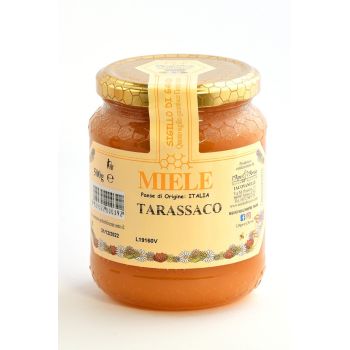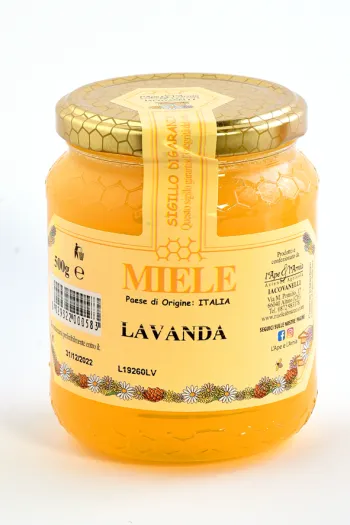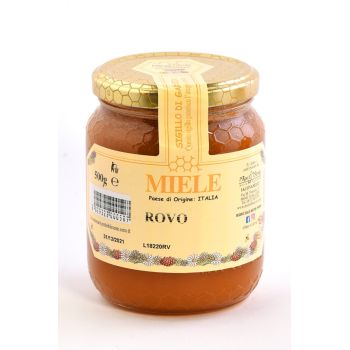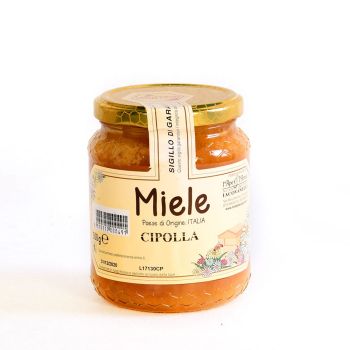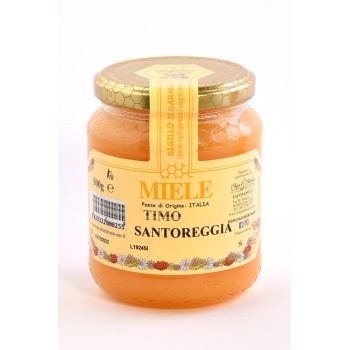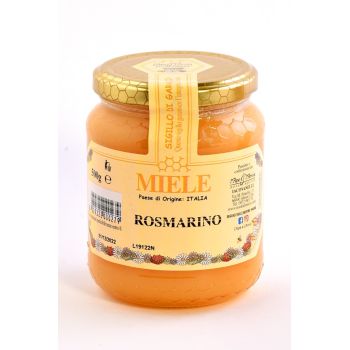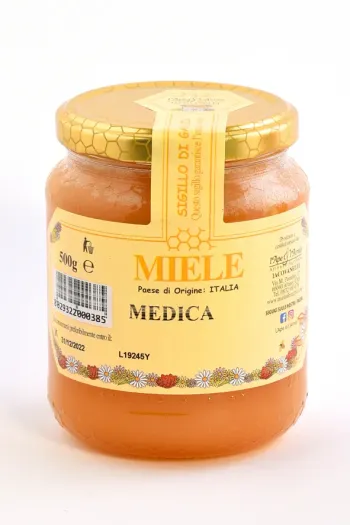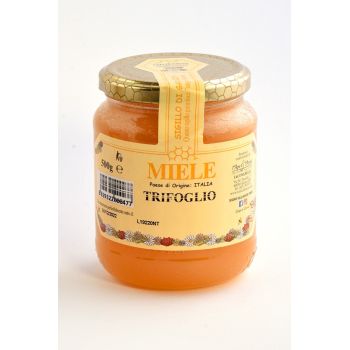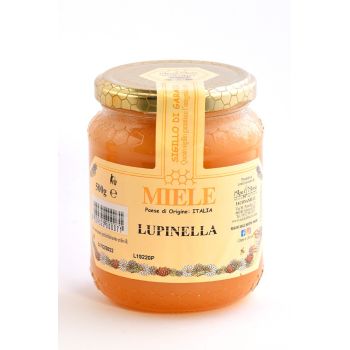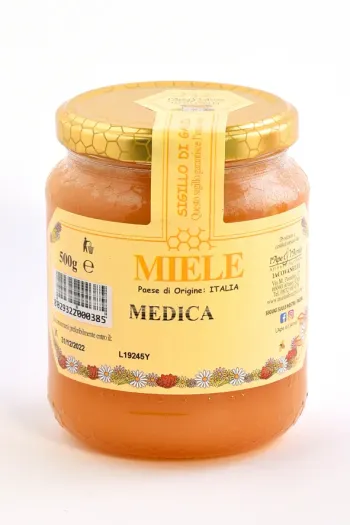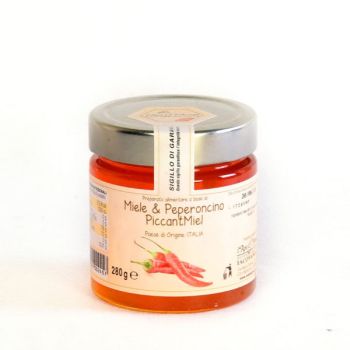The honey is processed in such a way as to break up the crystals and block crystallization. This method keeps the properties of honey intact and makes it creamy, spreadable and not "sticky."
The honey is processed in such a way as to break up the crystals and block crystallization. This method keeps the properties of honey intact and makes it creamy, spreadable and not "sticky."
Mixed flower honey processed for 48 hours by a machine that makes it frothy and spreadable. Weight 250 g or 400 g Extracted, prepared and packaged by cold process. ITALIAN HONEY produced in the Orobic area - Lombardy
Mixed flower honey processed for 48 hours by a machine that makes it frothy and spreadable. Weight 250 g or 400 g Extracted, prepared and packaged by cold process. ITALIAN HONEY produced in the Orobic area - Lombardy
Mixed flower honey processed for 48 hours by a machine that makes it frothy and spreadable. Weight 250 g or 400 g Extracted, prepared and packaged by cold process. ITALIAN HONEY produced in the Orobic area - Lombardy
Honeydew is the only honey not of floral origin; in fact, it takes its name from the Metcalfa pruinosa (an insect) that, feeding on plant sap, expels the sugary part which is then collected by bees. The honey remains liquid for a long time presenting a dark color tending to black. The smell has vegetal and fruity notes of cooked fruit while the taste is not very sweet, medium intensity and reminiscent of molasses, dates or fig jam. Packaging in 500 g or 1 kg jars.
Honeydew is the only honey not of floral origin; in fact, it takes its name from the Metcalfa pruinosa (an insect) that, feeding on plant sap, expels the sugary part which is then collected by bees. The honey remains liquid for a long time presenting a dark color tending to black. The smell has vegetal and fruity notes of cooked fruit while the taste is not very sweet, medium intensity and reminiscent of molasses, dates or fig jam. Packaging in 500 g or 1 kg jars.
Honeydew is the only honey not of floral origin; in fact, it takes its name from the Metcalfa pruinosa (an insect) that, feeding on plant sap, expels the sugary part which is then collected by bees. The honey remains liquid for a long time presenting a dark color tending to black. The smell has vegetal and fruity notes of cooked fruit while the taste is not very sweet, medium intensity and reminiscent of molasses, dates or fig jam. Packaging in 500 g or 1 kg jars.
The honey is processed in such a way as to break up the crystals and block crystallization. This method keeps the properties of honey intact and makes it creamy, spreadable and not "sticky."
The honey is processed in such a way as to break up the crystals and block crystallization. This method keeps the properties of honey intact and makes it creamy, spreadable and not "sticky."
Mixed flower honey creamy energy compound with pollen and propolis - Weight 250 gExtracted, produced and packaged by cold process ITALIAN HONEY produced in the Orobic area - Lombardy
Mixed flower honey creamy energy compound with pollen and propolis - Weight 250 gExtracted, produced and packaged by cold process ITALIAN HONEY produced in the Orobic area - Lombardy
Mixed flower honey creamy energy compound with pollen and propolis - Weight 250 gExtracted, produced and packaged by cold process ITALIAN HONEY produced in the Orobic area - Lombardy
The Honey Crystallization ProcessAny honey can occur in the crystallized form with the exception of Acacia honey, Chestnut honey and honeydew honeys, which generally tend not to crystallize.Honey crystallization is a natural process that can occur over time. When honey contains more glucose than fructose, it is more likely to crystallize. Crystallization begins when glucose molecules aggregate to form crystals. These crystals spread through the honey, giving the solution a thicker, grainier consistency.The speed and extent of crystallization depend on various factors, including temperature and honey composition.Crystallization can take days to weeks to fully develop.
The Honey Crystallization ProcessAny honey can occur in the crystallized form with the exception of Acacia honey, Chestnut honey and honeydew honeys, which generally tend not to crystallize.Honey crystallization is a natural process that can occur over time. When honey contains more glucose than fructose, it is more likely to crystallize. Crystallization begins when glucose molecules aggregate to form crystals. These crystals spread through the honey, giving the solution a thicker, grainier consistency.The speed and extent of crystallization depend on various factors, including temperature and honey composition.Crystallization can take days to weeks to fully develop.
LEMON HONEY 500 g, product may appear crystallized. Lemon honey is dark amber in color when liquid, lighter when crystallized; with a faint, fruity odor and flavor, it is highly valued in teas and herbal teas. Country of origin :ITALY Storage conditions: store at room temperature in a dry place
LEMON HONEY 500 g, product may appear crystallized. Lemon honey is dark amber in color when liquid, lighter when crystallized; with a faint, fruity odor and flavor, it is highly valued in teas and herbal teas. Country of origin :ITALY Storage conditions: store at room temperature in a dry place
LEMON HONEY 500 g, product may appear crystallized. Lemon honey is dark amber in color when liquid, lighter when crystallized; with a faint, fruity odor and flavor, it is highly valued in teas and herbal teas. Country of origin :ITALY Storage conditions: store at room temperature in a dry place
The Honey Crystallization ProcessAny honey can occur in the crystallized form with the exception of Acacia honey, Chestnut honey and honeydew honeys, which generally tend not to crystallize.Honey crystallization is a natural process that can occur over time. When honey contains more glucose than fructose, it is more likely to crystallize. Crystallization begins when glucose molecules aggregate to form crystals. These crystals spread through the honey, giving the solution a thicker, grainier consistency.The speed and extent of crystallization depend on various factors, including temperature and honey composition.Crystallization can take days to weeks to fully develop.
The Honey Crystallization ProcessAny honey can occur in the crystallized form with the exception of Acacia honey, Chestnut honey and honeydew honeys, which generally tend not to crystallize.Honey crystallization is a natural process that can occur over time. When honey contains more glucose than fructose, it is more likely to crystallize. Crystallization begins when glucose molecules aggregate to form crystals. These crystals spread through the honey, giving the solution a thicker, grainier consistency.The speed and extent of crystallization depend on various factors, including temperature and honey composition.Crystallization can take days to weeks to fully develop.
Orange honey is recognized as one of the best and most popular table honeys and as a beverage sweetener because of its delicate, floral taste; its color, which is clear, is also identifiable with consumers' idea of honey. COUNTRY OF PRODUCTION: ITALY Storage conditions: store at room temperature in a dry place
Orange honey is recognized as one of the best and most popular table honeys and as a beverage sweetener because of its delicate, floral taste; its color, which is clear, is also identifiable with consumers' idea of honey. COUNTRY OF PRODUCTION: ITALY Storage conditions: store at room temperature in a dry place
Orange honey is recognized as one of the best and most popular table honeys and as a beverage sweetener because of its delicate, floral taste; its color, which is clear, is also identifiable with consumers' idea of honey. COUNTRY OF PRODUCTION: ITALY Storage conditions: store at room temperature in a dry place
The honey is processed in such a way as to break up the crystals and block crystallization. This method keeps the properties of honey intact and makes it creamy, spreadable and not "sticky."
The honey is processed in such a way as to break up the crystals and block crystallization. This method keeps the properties of honey intact and makes it creamy, spreadable and not "sticky."
Compound to soothe the effects of coughs and colds made from Mixed flower honey creamy with propolis and essential oils of eucalyptus, mountain pine and thyme - Weight 250 g Extracted, prepared and packaged by cold process ITALIAN HONEY produced in the Orobica area - Lombardy
Compound to soothe the effects of coughs and colds made from Mixed flower honey creamy with propolis and essential oils of eucalyptus, mountain pine and thyme - Weight 250 g Extracted, prepared and packaged by cold process ITALIAN HONEY produced in the Orobica area - Lombardy
Compound to soothe the effects of coughs and colds made from Mixed flower honey creamy with propolis and essential oils of eucalyptus, mountain pine and thyme - Weight 250 g Extracted, prepared and packaged by cold process ITALIAN HONEY produced in the Orobica area - Lombardy
Orange honey, characterized by an intense and engaging aroma reminiscent of oranges, has a flavor that is instead delicate and in some cases slightly acidic, the color is very light, similar to a straw yellow. What properties does orange honey have? It has a relaxing and calming effect and is often recommended for relieving states of anxiety and counteracting headaches and insomnia. It is also believed to stimulate appetite, as well as aid digestion after an overly large meal. The Process of Honey CrystallizationAny honey can occur in the crystallized form with the exception of Acacia honey, Chestnut honey and honeydew honeys, which generally tend not to crystallize.Honey crystallization is a natural process that can occur over time. When honey contains more glucose than fructose, it is more likely to crystallize. Crystallization begins when glucose molecules aggregate to form crystals. These crystals spread through the honey, giving the solution a thicker, grainier consistency.The speed and extent of crystallization depend on various factors, including temperature and honey composition.Crystallization can take days to weeks to fully develop.
Orange honey, characterized by an intense and engaging aroma reminiscent of oranges, has a flavor that is instead delicate and in some cases slightly acidic, the color is very light, similar to a straw yellow. What properties does orange honey have? It has a relaxing and calming effect and is often recommended for relieving states of anxiety and counteracting headaches and insomnia. It is also believed to stimulate appetite, as well as aid digestion after an overly large meal. The Process of Honey CrystallizationAny honey can occur in the crystallized form with the exception of Acacia honey, Chestnut honey and honeydew honeys, which generally tend not to crystallize.Honey crystallization is a natural process that can occur over time. When honey contains more glucose than fructose, it is more likely to crystallize. Crystallization begins when glucose molecules aggregate to form crystals. These crystals spread through the honey, giving the solution a thicker, grainier consistency.The speed and extent of crystallization depend on various factors, including temperature and honey composition.Crystallization can take days to weeks to fully develop.
Orange "citrus" honey harvested in May in the citrus groves of the Gioia Tauro Plain in Calabria, Italy. The product may appear crystallized. Store cool and dry Country of production: Italy Average nutritional values per 100 g of product: Energy: 324 kcal/ 1375 kj Fat 0 g of which saturated 0 g Carbohydrates 80.3 g of which Sugars 80.3 g Protein: 0.6 g Salt 0.3 g
Orange "citrus" honey harvested in May in the citrus groves of the Gioia Tauro Plain in Calabria, Italy. The product may appear crystallized. Store cool and dry Country of production: Italy Average nutritional values per 100 g of product: Energy: 324 kcal/ 1375 kj Fat 0 g of which saturated 0 g Carbohydrates 80.3 g of which Sugars 80.3 g Protein: 0.6 g Salt 0.3 g
Orange "citrus" honey harvested in May in the citrus groves of the Gioia Tauro Plain in Calabria, Italy. The product may appear crystallized. Store cool and dry Country of production: Italy Average nutritional values per 100 g of product: Energy: 324 kcal/ 1375 kj Fat 0 g of which saturated 0 g Carbohydrates 80.3 g of which Sugars 80.3 g Protein: 0.6 g Salt 0.3 g
The honey is processed in such a way as to break up the crystals and block crystallization. This method keeps the properties of honey intact and makes it creamy, spreadable and not "sticky."
The honey is processed in such a way as to break up the crystals and block crystallization. This method keeps the properties of honey intact and makes it creamy, spreadable and not "sticky."
Mixed flower honey cream base with cocoa and cinnamon - Weight 250g Extracted, prepared and packaged by cold process ITALIAN HONEY produced in the Orobic area - Lombardy
Mixed flower honey cream base with cocoa and cinnamon - Weight 250g Extracted, prepared and packaged by cold process ITALIAN HONEY produced in the Orobic area - Lombardy
Mixed flower honey cream base with cocoa and cinnamon - Weight 250g Extracted, prepared and packaged by cold process ITALIAN HONEY produced in the Orobic area - Lombardy
The Honey Crystallization Process Any honey can occur in the crystallized form with the exception of Acacia honey, Chestnut honey and honeydew honeys, which generally tend not to crystallize. Honey crystallization is a natural process that can occur over time. When honey contains more glucose than fructose, it is more likely to crystallize. Crystallization begins when glucose molecules aggregate to form crystals. These crystals diffuse through the honey, giving the solution a thicker, grainier consistency.The speed and extent of crystallization depend on various factors, including temperature and honey composition. Crystallization can take days to weeks to fully develop.
The Honey Crystallization Process Any honey can occur in the crystallized form with the exception of Acacia honey, Chestnut honey and honeydew honeys, which generally tend not to crystallize. Honey crystallization is a natural process that can occur over time. When honey contains more glucose than fructose, it is more likely to crystallize. Crystallization begins when glucose molecules aggregate to form crystals. These crystals diffuse through the honey, giving the solution a thicker, grainier consistency.The speed and extent of crystallization depend on various factors, including temperature and honey composition. Crystallization can take days to weeks to fully develop.
Mandarin "citrus" honey harvested in May in the citrus groves of the Piana di Sibari in Calabria, Italy. The product may appear crystallized. Store cool and dry Country of production: Italy Average nutritional values per 100 g of product: Energy: 324 kcal/ 1375 kj Fat 0 g of which saturated 0 g Carbohydrates 80.3 g of which Sugars 80.3 g Protein: 0.6 g Salt 0.3 g
Mandarin "citrus" honey harvested in May in the citrus groves of the Piana di Sibari in Calabria, Italy. The product may appear crystallized. Store cool and dry Country of production: Italy Average nutritional values per 100 g of product: Energy: 324 kcal/ 1375 kj Fat 0 g of which saturated 0 g Carbohydrates 80.3 g of which Sugars 80.3 g Protein: 0.6 g Salt 0.3 g
Mandarin "citrus" honey harvested in May in the citrus groves of the Piana di Sibari in Calabria, Italy. The product may appear crystallized. Store cool and dry Country of production: Italy Average nutritional values per 100 g of product: Energy: 324 kcal/ 1375 kj Fat 0 g of which saturated 0 g Carbohydrates 80.3 g of which Sugars 80.3 g Protein: 0.6 g Salt 0.3 g
The honey is processed in such a way as to break up the crystals and block crystallization. This method keeps the properties of honey intact and makes it creamy, spreadable and not "sticky."
The honey is processed in such a way as to break up the crystals and block crystallization. This method keeps the properties of honey intact and makes it creamy, spreadable and not "sticky."
Creamy Mixed flower honey with salted peanuts - Weight 250g Ingredients: 65% honey, 35% salted peanuts (peanut cream and salt) Extracted, prepared and packaged by cold process. ITALIAN HONEY produced in the Orobic area - Lombardy
Creamy Mixed flower honey with salted peanuts - Weight 250g Ingredients: 65% honey, 35% salted peanuts (peanut cream and salt) Extracted, prepared and packaged by cold process. ITALIAN HONEY produced in the Orobic area - Lombardy
Creamy Mixed flower honey with salted peanuts - Weight 250g Ingredients: 65% honey, 35% salted peanuts (peanut cream and salt) Extracted, prepared and packaged by cold process. ITALIAN HONEY produced in the Orobic area - Lombardy
The Honey Crystallization ProcessAny honey can occur in the crystallized form with the exception of Acacia honey, Chestnut honey and honeydew honeys, which generally tend not to crystallize.Honey crystallization is a natural process that can occur over time. When honey contains more glucose than fructose, it is more likely to crystallize. Crystallization begins when glucose molecules aggregate to form crystals. These crystals spread through the honey, giving the solution a thicker, grainier consistency.The speed and extent of crystallization depend on various factors, including temperature and honey composition.Crystallization can take days to weeks to fully develop.
The Honey Crystallization ProcessAny honey can occur in the crystallized form with the exception of Acacia honey, Chestnut honey and honeydew honeys, which generally tend not to crystallize.Honey crystallization is a natural process that can occur over time. When honey contains more glucose than fructose, it is more likely to crystallize. Crystallization begins when glucose molecules aggregate to form crystals. These crystals spread through the honey, giving the solution a thicker, grainier consistency.The speed and extent of crystallization depend on various factors, including temperature and honey composition.Crystallization can take days to weeks to fully develop.
Thistle honey is generally amber in color with orange hues when crystallized and green reflections when liquid.The smell and taste are persistent and of medium intensity assimilable, to cut bark with floral-fruity notes. COUNTRY OF PRODUCTION: ITALY Storage conditions: store at room temperature in a dry place
Thistle honey is generally amber in color with orange hues when crystallized and green reflections when liquid.The smell and taste are persistent and of medium intensity assimilable, to cut bark with floral-fruity notes. COUNTRY OF PRODUCTION: ITALY Storage conditions: store at room temperature in a dry place
Thistle honey is generally amber in color with orange hues when crystallized and green reflections when liquid.The smell and taste are persistent and of medium intensity assimilable, to cut bark with floral-fruity notes. COUNTRY OF PRODUCTION: ITALY Storage conditions: store at room temperature in a dry place
The Honey Crystallization ProcessAny honey can occur in the crystallized form with the exception of Acacia honey, Chestnut honey and honeydew honeys, which generally tend not to crystallize.Honey crystallization is a natural process that can occur over time. When honey contains more glucose than fructose, it is more likely to crystallize. Crystallization begins when glucose molecules aggregate to form crystals. These crystals spread through the honey, giving the solution a thicker, grainier consistency.The speed and extent of crystallization depend on various factors, including temperature and honey composition.Crystallization can take days to weeks to fully develop.
The Honey Crystallization ProcessAny honey can occur in the crystallized form with the exception of Acacia honey, Chestnut honey and honeydew honeys, which generally tend not to crystallize.Honey crystallization is a natural process that can occur over time. When honey contains more glucose than fructose, it is more likely to crystallize. Crystallization begins when glucose molecules aggregate to form crystals. These crystals spread through the honey, giving the solution a thicker, grainier consistency.The speed and extent of crystallization depend on various factors, including temperature and honey composition.Crystallization can take days to weeks to fully develop.
Cherry honey, the product may appear crystallized. Cherry honey is light almost grayish in color when crystallized; the aroma, initially sweet with a hint of bitterness, is reminiscent of cherry pits or bitter almond. COUNTRY OF PRODUCTION: ITALY Storage conditions: store at room temperature in a dry place Packaging in 500 g or 1 kg jars
Cherry honey, the product may appear crystallized. Cherry honey is light almost grayish in color when crystallized; the aroma, initially sweet with a hint of bitterness, is reminiscent of cherry pits or bitter almond. COUNTRY OF PRODUCTION: ITALY Storage conditions: store at room temperature in a dry place Packaging in 500 g or 1 kg jars
Cherry honey, the product may appear crystallized. Cherry honey is light almost grayish in color when crystallized; the aroma, initially sweet with a hint of bitterness, is reminiscent of cherry pits or bitter almond. COUNTRY OF PRODUCTION: ITALY Storage conditions: store at room temperature in a dry place Packaging in 500 g or 1 kg jars
The Honey Crystallization ProcessAny honey can occur in the crystallized form with the exception of Acacia honey, Chestnut honey and honeydew honeys, which generally tend not to crystallize.Honey crystallization is a natural process that can occur over time. When honey contains more glucose than fructose, it is more likely to crystallize. Crystallization begins when glucose molecules aggregate to form crystals. These crystals spread through the honey, giving the solution a thicker, grainier consistency.The speed and extent of crystallization depend on various factors, including temperature and honey composition.Crystallization can take days to weeks to fully develop.
The Honey Crystallization ProcessAny honey can occur in the crystallized form with the exception of Acacia honey, Chestnut honey and honeydew honeys, which generally tend not to crystallize.Honey crystallization is a natural process that can occur over time. When honey contains more glucose than fructose, it is more likely to crystallize. Crystallization begins when glucose molecules aggregate to form crystals. These crystals spread through the honey, giving the solution a thicker, grainier consistency.The speed and extent of crystallization depend on various factors, including temperature and honey composition.Crystallization can take days to weeks to fully develop.
Corbezzolo is a rare plant with a peculiar history: the green of the stem, the white of the flowers and the red of the fruits inspired the Italian flag and was one of the symbols of the Risorgimento.The honey derived from it is really peculiar in that it is one of the few honeys to have a taste with a strong bitter and astringent component.The nose also reminds one of coffee grounds or cocoa beans.Its peculiarity makes it really interesting in combination with cheeses (tending to be the sweeter ones) and its bitterness complements that of coffee making the drink better. The product may appear crystallized. COUNTRY OF PRODUCTION: ITALY Storage conditions: store at room temperature in a dry place
Corbezzolo is a rare plant with a peculiar history: the green of the stem, the white of the flowers and the red of the fruits inspired the Italian flag and was one of the symbols of the Risorgimento.The honey derived from it is really peculiar in that it is one of the few honeys to have a taste with a strong bitter and astringent component.The nose also reminds one of coffee grounds or cocoa beans.Its peculiarity makes it really interesting in combination with cheeses (tending to be the sweeter ones) and its bitterness complements that of coffee making the drink better. The product may appear crystallized. COUNTRY OF PRODUCTION: ITALY Storage conditions: store at room temperature in a dry place
Corbezzolo is a rare plant with a peculiar history: the green of the stem, the white of the flowers and the red of the fruits inspired the Italian flag and was one of the symbols of the Risorgimento.The honey derived from it is really peculiar in that it is one of the few honeys to have a taste with a strong bitter and astringent component.The nose also reminds one of coffee grounds or cocoa beans.Its peculiarity makes it really interesting in combination with cheeses (tending to be the sweeter ones) and its bitterness complements that of coffee making the drink better. The product may appear crystallized. COUNTRY OF PRODUCTION: ITALY Storage conditions: store at room temperature in a dry place
The Honey Crystallization ProcessAny honey can occur in the crystallized form with the exception of Acacia honey, Chestnut honey and honeydew honeys, which generally tend not to crystallize.Honey crystallization is a natural process that can occur over time. When honey contains more glucose than fructose, it is more likely to crystallize. Crystallization begins when glucose molecules aggregate to form crystals. These crystals spread through the honey, giving the solution a thicker, grainier consistency.The speed and extent of crystallization depend on various factors, including temperature and honey composition.Crystallization can take days to weeks to fully develop.
The Honey Crystallization ProcessAny honey can occur in the crystallized form with the exception of Acacia honey, Chestnut honey and honeydew honeys, which generally tend not to crystallize.Honey crystallization is a natural process that can occur over time. When honey contains more glucose than fructose, it is more likely to crystallize. Crystallization begins when glucose molecules aggregate to form crystals. These crystals spread through the honey, giving the solution a thicker, grainier consistency.The speed and extent of crystallization depend on various factors, including temperature and honey composition.Crystallization can take days to weeks to fully develop.
EUCALYPTUS HONEY 500 g Eucalyptus honey is light to dark amber in color when liquid, with a grayish beige hue when crystallized; odor and flavor are of medium intensity both, however, not very fine, with hints of dried mushrooms or toffee. Popular for its soothing properties in cold illnesses.
EUCALYPTUS HONEY 500 g Eucalyptus honey is light to dark amber in color when liquid, with a grayish beige hue when crystallized; odor and flavor are of medium intensity both, however, not very fine, with hints of dried mushrooms or toffee. Popular for its soothing properties in cold illnesses.
EUCALYPTUS HONEY 500 g Eucalyptus honey is light to dark amber in color when liquid, with a grayish beige hue when crystallized; odor and flavor are of medium intensity both, however, not very fine, with hints of dried mushrooms or toffee. Popular for its soothing properties in cold illnesses.
The Honey Crystallization ProcessAny honey can occur in the crystallized form with the exception of Acacia honey, Chestnut honey and honeydew honeys, which generally tend not to crystallize.Honey crystallization is a natural process that can occur over time. When honey contains more glucose than fructose, it is more likely to crystallize. Crystallization begins when glucose molecules aggregate to form crystals. These crystals spread through the honey, giving the solution a thicker, grainier consistency.The speed and extent of crystallization depend on various factors, including temperature and honey composition.Crystallization can take days to weeks to fully develop.
The Honey Crystallization ProcessAny honey can occur in the crystallized form with the exception of Acacia honey, Chestnut honey and honeydew honeys, which generally tend not to crystallize.Honey crystallization is a natural process that can occur over time. When honey contains more glucose than fructose, it is more likely to crystallize. Crystallization begins when glucose molecules aggregate to form crystals. These crystals spread through the honey, giving the solution a thicker, grainier consistency.The speed and extent of crystallization depend on various factors, including temperature and honey composition.Crystallization can take days to weeks to fully develop.
In melissopalinology the presence of Sulla pollen is considered as an index of the honey's Italian origin, and until a few years ago unifloral honeys of sulla were produced abundantly in almost all of the peninsula while today such production is limited to the hilly areas of Abruzzo, Molise, Calabria, Sicily and Sardinia.The light color (light beige when crystallized), flavor and uncharacteristic odor (described in fact as "honey-like" with a slight vegetal note of hay) make it highly valued for all uses. COUNTRY OF PRODUCTION: ITALY Storage conditions: store at room temperature in a dry place
In melissopalinology the presence of Sulla pollen is considered as an index of the honey's Italian origin, and until a few years ago unifloral honeys of sulla were produced abundantly in almost all of the peninsula while today such production is limited to the hilly areas of Abruzzo, Molise, Calabria, Sicily and Sardinia.The light color (light beige when crystallized), flavor and uncharacteristic odor (described in fact as "honey-like" with a slight vegetal note of hay) make it highly valued for all uses. COUNTRY OF PRODUCTION: ITALY Storage conditions: store at room temperature in a dry place
In melissopalinology the presence of Sulla pollen is considered as an index of the honey's Italian origin, and until a few years ago unifloral honeys of sulla were produced abundantly in almost all of the peninsula while today such production is limited to the hilly areas of Abruzzo, Molise, Calabria, Sicily and Sardinia.The light color (light beige when crystallized), flavor and uncharacteristic odor (described in fact as "honey-like" with a slight vegetal note of hay) make it highly valued for all uses. COUNTRY OF PRODUCTION: ITALY Storage conditions: store at room temperature in a dry place
The Honey Crystallization ProcessAny honey can occur in the crystallized form with the exception of Acacia honey, Chestnut honey and honeydew honeys, which generally tend not to crystallize.Honey crystallization is a natural process that can occur over time. When honey contains more glucose than fructose, it is more likely to crystallize. Crystallization begins when glucose molecules aggregate to form crystals. These crystals spread through the honey, giving the solution a thicker, grainier consistency.The speed and extent of crystallization depend on various factors, including temperature and honey composition.Crystallization can take days to weeks to fully develop.
The Honey Crystallization ProcessAny honey can occur in the crystallized form with the exception of Acacia honey, Chestnut honey and honeydew honeys, which generally tend not to crystallize.Honey crystallization is a natural process that can occur over time. When honey contains more glucose than fructose, it is more likely to crystallize. Crystallization begins when glucose molecules aggregate to form crystals. These crystals spread through the honey, giving the solution a thicker, grainier consistency.The speed and extent of crystallization depend on various factors, including temperature and honey composition.Crystallization can take days to weeks to fully develop.
Sunflower honey 500g, product may appear crystallized.Sunflower honey is a typical production of central Italy.It has a bright yellow color that when it crystallizes (very quickly) becomes more cream-colored.Mild flavor and pollen and "wax-like" odor offers a refreshing sensation. COUNTRY OF PRODUCTION: ITALY Storage conditions: store at room temperature in a dry place
Sunflower honey 500g, product may appear crystallized.Sunflower honey is a typical production of central Italy.It has a bright yellow color that when it crystallizes (very quickly) becomes more cream-colored.Mild flavor and pollen and "wax-like" odor offers a refreshing sensation. COUNTRY OF PRODUCTION: ITALY Storage conditions: store at room temperature in a dry place
Sunflower honey 500g, product may appear crystallized.Sunflower honey is a typical production of central Italy.It has a bright yellow color that when it crystallizes (very quickly) becomes more cream-colored.Mild flavor and pollen and "wax-like" odor offers a refreshing sensation. COUNTRY OF PRODUCTION: ITALY Storage conditions: store at room temperature in a dry place
The Honey Crystallization ProcessAny honey can occur in the crystallized form with the exception of Acacia honey, Chestnut honey and honeydew honeys, which generally tend not to crystallize.Honey crystallization is a natural process that can occur over time. When honey contains more glucose than fructose, it is more likely to crystallize. Crystallization begins when glucose molecules aggregate to form crystals. These crystals spread through the honey, giving the solution a thicker, grainier consistency.The speed and extent of crystallization depend on various factors, including temperature and honey composition.Crystallization can take days to weeks to fully develop.
The Honey Crystallization ProcessAny honey can occur in the crystallized form with the exception of Acacia honey, Chestnut honey and honeydew honeys, which generally tend not to crystallize.Honey crystallization is a natural process that can occur over time. When honey contains more glucose than fructose, it is more likely to crystallize. Crystallization begins when glucose molecules aggregate to form crystals. These crystals spread through the honey, giving the solution a thicker, grainier consistency.The speed and extent of crystallization depend on various factors, including temperature and honey composition.Crystallization can take days to weeks to fully develop.
Dandelion honey has characteristics that are not appreciated by most consumers, i.e., pungent odor and flavor, of dried flowers and with animal notes; it is a "difficult" honey but precisely for this reason it finds wide success among consumers who like special honeys.The color is amber with yellow highlights in liquid honey, creamy yellow with beige to amber hues when crystallized. COUNTRY OF PRODUCTION: ITALY Storage conditions: store at room temperature in a dry place
Dandelion honey has characteristics that are not appreciated by most consumers, i.e., pungent odor and flavor, of dried flowers and with animal notes; it is a "difficult" honey but precisely for this reason it finds wide success among consumers who like special honeys.The color is amber with yellow highlights in liquid honey, creamy yellow with beige to amber hues when crystallized. COUNTRY OF PRODUCTION: ITALY Storage conditions: store at room temperature in a dry place
Dandelion honey has characteristics that are not appreciated by most consumers, i.e., pungent odor and flavor, of dried flowers and with animal notes; it is a "difficult" honey but precisely for this reason it finds wide success among consumers who like special honeys.The color is amber with yellow highlights in liquid honey, creamy yellow with beige to amber hues when crystallized. COUNTRY OF PRODUCTION: ITALY Storage conditions: store at room temperature in a dry place
The Honey Crystallization ProcessAny honey can occur in the crystallized form with the exception of Acacia honey, Chestnut honey and honeydew honeys, which generally tend not to crystallize.Honey crystallization is a natural process that can occur over time. When honey contains more glucose than fructose, it is more likely to crystallize. Crystallization begins when glucose molecules aggregate to form crystals. These crystals spread through the honey, giving the solution a thicker, grainier consistency.The speed and extent of crystallization depend on various factors, including temperature and honey composition.Crystallization can take days to weeks to fully develop.
The Honey Crystallization ProcessAny honey can occur in the crystallized form with the exception of Acacia honey, Chestnut honey and honeydew honeys, which generally tend not to crystallize.Honey crystallization is a natural process that can occur over time. When honey contains more glucose than fructose, it is more likely to crystallize. Crystallization begins when glucose molecules aggregate to form crystals. These crystals spread through the honey, giving the solution a thicker, grainier consistency.The speed and extent of crystallization depend on various factors, including temperature and honey composition.Crystallization can take days to weeks to fully develop.
500g Heather honey, the product may appear crystallized.Heather honey crystallizes quickly, yet even in its liquid state it is never perfectly clear. The color is dark amber with red highlights in liquid honey while crystallized the color turns more to brown. The smell of medium intensity is fresh and reminiscent of caramel, as is also the taste, lingering and with a vegetal note. COUNTRY OF PRODUCTION: ITALY Storage conditions: store at room temperature in a dry place
500g Heather honey, the product may appear crystallized.Heather honey crystallizes quickly, yet even in its liquid state it is never perfectly clear. The color is dark amber with red highlights in liquid honey while crystallized the color turns more to brown. The smell of medium intensity is fresh and reminiscent of caramel, as is also the taste, lingering and with a vegetal note. COUNTRY OF PRODUCTION: ITALY Storage conditions: store at room temperature in a dry place
500g Heather honey, the product may appear crystallized.Heather honey crystallizes quickly, yet even in its liquid state it is never perfectly clear. The color is dark amber with red highlights in liquid honey while crystallized the color turns more to brown. The smell of medium intensity is fresh and reminiscent of caramel, as is also the taste, lingering and with a vegetal note. COUNTRY OF PRODUCTION: ITALY Storage conditions: store at room temperature in a dry place
The Honey Crystallization ProcessAny honey can occur in the crystallized form with the exception of Acacia honey, Chestnut honey and honeydew honeys, which generally tend not to crystallize.Honey crystallization is a natural process that can occur over time. When honey contains more glucose than fructose, it is more likely to crystallize. Crystallization begins when glucose molecules aggregate to form crystals. These crystals diffuse through the honey, giving the solution a thicker, grainier consistency.The speed and extent of crystallization depend on various factors, including temperature and honey composition.Crystallization can take days to weeks to fully develop.
The Honey Crystallization ProcessAny honey can occur in the crystallized form with the exception of Acacia honey, Chestnut honey and honeydew honeys, which generally tend not to crystallize.Honey crystallization is a natural process that can occur over time. When honey contains more glucose than fructose, it is more likely to crystallize. Crystallization begins when glucose molecules aggregate to form crystals. These crystals diffuse through the honey, giving the solution a thicker, grainier consistency.The speed and extent of crystallization depend on various factors, including temperature and honey composition.Crystallization can take days to weeks to fully develop.
Lavender Honey 500 gLavender honey is produced from the bloom of Wild Lavender is light yellow in color when liquid, more tending to white/beige when crystallized and with fine crystals. Of delicate aroma, it is excellent for all uses in cooking, delicious instead in combination with lettuce. Country of origin :ITALY Storage conditions: store at room temperature in a dry place
Lavender Honey 500 gLavender honey is produced from the bloom of Wild Lavender is light yellow in color when liquid, more tending to white/beige when crystallized and with fine crystals. Of delicate aroma, it is excellent for all uses in cooking, delicious instead in combination with lettuce. Country of origin :ITALY Storage conditions: store at room temperature in a dry place
Lavender Honey 500 gLavender honey is produced from the bloom of Wild Lavender is light yellow in color when liquid, more tending to white/beige when crystallized and with fine crystals. Of delicate aroma, it is excellent for all uses in cooking, delicious instead in combination with lettuce. Country of origin :ITALY Storage conditions: store at room temperature in a dry place
The Honey Crystallization ProcessAny honey can occur in the crystallized form with the exception of Acacia honey, Chestnut honey and honeydew honeys, which generally tend not to crystallize.Honey crystallization is a natural process that can occur over time. When honey contains more glucose than fructose, it is more likely to crystallize. Crystallization begins when glucose molecules aggregate to form crystals. These crystals spread through the honey, giving the solution a thicker, grainier consistency.The speed and extent of crystallization depend on various factors, including temperature and honey composition.Crystallization can take days to weeks to fully develop.
The Honey Crystallization ProcessAny honey can occur in the crystallized form with the exception of Acacia honey, Chestnut honey and honeydew honeys, which generally tend not to crystallize.Honey crystallization is a natural process that can occur over time. When honey contains more glucose than fructose, it is more likely to crystallize. Crystallization begins when glucose molecules aggregate to form crystals. These crystals spread through the honey, giving the solution a thicker, grainier consistency.The speed and extent of crystallization depend on various factors, including temperature and honey composition.Crystallization can take days to weeks to fully develop.
ROVO HONEY 500 gBROWBERRY HONEY (of Blackberries) tends to darken summer Mixed flower honeys.When monofloral its color in fact is dark amber to black, the smell is medium intense and the flavor is reminiscent of ripe fruit with a hint of rose. COUNTRY OF PRODUCTION: ITALY Storage conditions: store at room temperature in a dry place
ROVO HONEY 500 gBROWBERRY HONEY (of Blackberries) tends to darken summer Mixed flower honeys.When monofloral its color in fact is dark amber to black, the smell is medium intense and the flavor is reminiscent of ripe fruit with a hint of rose. COUNTRY OF PRODUCTION: ITALY Storage conditions: store at room temperature in a dry place
ROVO HONEY 500 gBROWBERRY HONEY (of Blackberries) tends to darken summer Mixed flower honeys.When monofloral its color in fact is dark amber to black, the smell is medium intense and the flavor is reminiscent of ripe fruit with a hint of rose. COUNTRY OF PRODUCTION: ITALY Storage conditions: store at room temperature in a dry place
The Honey Crystallization ProcessAny honey can occur in the crystallized form with the exception of Acacia honey, Chestnut honey and honeydew honeys, which generally tend not to crystallize.Honey crystallization is a natural process that can occur over time. When honey contains more glucose than fructose, it is more likely to crystallize. Crystallization begins when glucose molecules aggregate to form crystals. These crystals spread through the honey, giving the solution a thicker, grainier consistency.The speed and extent of crystallization depend on various factors, including temperature and honey composition.Crystallization can take days to weeks to fully develop.
The Honey Crystallization ProcessAny honey can occur in the crystallized form with the exception of Acacia honey, Chestnut honey and honeydew honeys, which generally tend not to crystallize.Honey crystallization is a natural process that can occur over time. When honey contains more glucose than fructose, it is more likely to crystallize. Crystallization begins when glucose molecules aggregate to form crystals. These crystals spread through the honey, giving the solution a thicker, grainier consistency.The speed and extent of crystallization depend on various factors, including temperature and honey composition.Crystallization can take days to weeks to fully develop.
THYME HONEY 500 g, the product may appear crystallized.Thyme honey, thanks to the presence of thymol, has multiple benefits on the body: it is digestive, depurative, balsamic and antibacterial. It is also useful in oral cavity infections and particularly effective against bad breath. COUNTRY OF PRODUCTION: ITALY Storage conditions: store at room temperature in a dry place
THYME HONEY 500 g, the product may appear crystallized.Thyme honey, thanks to the presence of thymol, has multiple benefits on the body: it is digestive, depurative, balsamic and antibacterial. It is also useful in oral cavity infections and particularly effective against bad breath. COUNTRY OF PRODUCTION: ITALY Storage conditions: store at room temperature in a dry place
THYME HONEY 500 g, the product may appear crystallized.Thyme honey, thanks to the presence of thymol, has multiple benefits on the body: it is digestive, depurative, balsamic and antibacterial. It is also useful in oral cavity infections and particularly effective against bad breath. COUNTRY OF PRODUCTION: ITALY Storage conditions: store at room temperature in a dry place
The Honey Crystallization ProcessAny honey can occur in the crystallized form with the exception of Acacia honey, Chestnut honey and honeydew honeys, which generally tend not to crystallize.Honey crystallization is a natural process that can occur over time. When honey contains more glucose than fructose, it is more likely to crystallize. Crystallization begins when glucose molecules aggregate to form crystals. These crystals spread through the honey, giving the solution a thicker, grainier consistency.The speed and extent of crystallization depend on various factors, including temperature and honey composition.Crystallization can take days to weeks to fully develop.
The Honey Crystallization ProcessAny honey can occur in the crystallized form with the exception of Acacia honey, Chestnut honey and honeydew honeys, which generally tend not to crystallize.Honey crystallization is a natural process that can occur over time. When honey contains more glucose than fructose, it is more likely to crystallize. Crystallization begins when glucose molecules aggregate to form crystals. These crystals spread through the honey, giving the solution a thicker, grainier consistency.The speed and extent of crystallization depend on various factors, including temperature and honey composition.Crystallization can take days to weeks to fully develop.
ROSEMARY HONEY 500 g, the product may appear crystallized.Rosemary honey is straw yellow when liquid while when crystallized it is white or ivory. Its very fine herbal taste makes it highly sought after, partly due to the notoriety of the botanical species of origin. COUNTRY OF PRODUCTION: ITALY Storage conditions: store at room temperature in a dry place
ROSEMARY HONEY 500 g, the product may appear crystallized.Rosemary honey is straw yellow when liquid while when crystallized it is white or ivory. Its very fine herbal taste makes it highly sought after, partly due to the notoriety of the botanical species of origin. COUNTRY OF PRODUCTION: ITALY Storage conditions: store at room temperature in a dry place
ROSEMARY HONEY 500 g, the product may appear crystallized.Rosemary honey is straw yellow when liquid while when crystallized it is white or ivory. Its very fine herbal taste makes it highly sought after, partly due to the notoriety of the botanical species of origin. COUNTRY OF PRODUCTION: ITALY Storage conditions: store at room temperature in a dry place
The Honey Crystallization ProcessAny honey can occur in the crystallized form with the exception of Acacia honey, Chestnut honey and honeydew honeys, which generally tend not to crystallize.Honey crystallization is a natural process that can occur over time. When honey contains more glucose than fructose, it is more likely to crystallize. Crystallization begins when glucose molecules aggregate to form crystals. These crystals diffuse through the honey, giving the solution a thicker, grainier consistency.The speed and extent of crystallization depend on various factors, including temperature and honey composition.Crystallization can take days to weeks to fully develop.
The Honey Crystallization ProcessAny honey can occur in the crystallized form with the exception of Acacia honey, Chestnut honey and honeydew honeys, which generally tend not to crystallize.Honey crystallization is a natural process that can occur over time. When honey contains more glucose than fructose, it is more likely to crystallize. Crystallization begins when glucose molecules aggregate to form crystals. These crystals diffuse through the honey, giving the solution a thicker, grainier consistency.The speed and extent of crystallization depend on various factors, including temperature and honey composition.Crystallization can take days to weeks to fully develop.
Coriander honey 500 g, the product may appear crystallized. Coriander is a member of the Umbrelliferae family, like parsley, and its fruits are used as a spice; the honey has a color tending to pale orange while the medium-sweet flavor has a slightly spicy, tangy aftertaste. Highly valued for characterizing hard nougats. Country of origin: ITALY Storage conditions: store at room temperature in a dry place
Coriander honey 500 g, the product may appear crystallized. Coriander is a member of the Umbrelliferae family, like parsley, and its fruits are used as a spice; the honey has a color tending to pale orange while the medium-sweet flavor has a slightly spicy, tangy aftertaste. Highly valued for characterizing hard nougats. Country of origin: ITALY Storage conditions: store at room temperature in a dry place
Coriander honey 500 g, the product may appear crystallized. Coriander is a member of the Umbrelliferae family, like parsley, and its fruits are used as a spice; the honey has a color tending to pale orange while the medium-sweet flavor has a slightly spicy, tangy aftertaste. Highly valued for characterizing hard nougats. Country of origin: ITALY Storage conditions: store at room temperature in a dry place
The Honey Crystallization ProcessAny honey can occur in the crystallized form with the exception of Acacia honey, Chestnut honey and honeydew honeys, which generally tend not to crystallize.Honey crystallization is a natural process that can occur over time. When honey contains more glucose than fructose, it is more likely to crystallize. Crystallization begins when glucose molecules aggregate to form crystals. These crystals spread through the honey, giving the solution a thicker, grainier consistency.The speed and extent of crystallization depend on various factors, including temperature and honey composition.Crystallization can take days to weeks to fully develop.
The Honey Crystallization ProcessAny honey can occur in the crystallized form with the exception of Acacia honey, Chestnut honey and honeydew honeys, which generally tend not to crystallize.Honey crystallization is a natural process that can occur over time. When honey contains more glucose than fructose, it is more likely to crystallize. Crystallization begins when glucose molecules aggregate to form crystals. These crystals spread through the honey, giving the solution a thicker, grainier consistency.The speed and extent of crystallization depend on various factors, including temperature and honey composition.Crystallization can take days to weeks to fully develop.
TRIFLOWER HONEY 500 g, the product may appear crystallized. Clover honey is milky white or off-white in color when crystallized, mild and vegetal in flavor and odor with a hint of milk candy. COUNTRY OF PRODUCTION: ITALY Storage conditions: store at room temperature in a dry place
TRIFLOWER HONEY 500 g, the product may appear crystallized. Clover honey is milky white or off-white in color when crystallized, mild and vegetal in flavor and odor with a hint of milk candy. COUNTRY OF PRODUCTION: ITALY Storage conditions: store at room temperature in a dry place
TRIFLOWER HONEY 500 g, the product may appear crystallized. Clover honey is milky white or off-white in color when crystallized, mild and vegetal in flavor and odor with a hint of milk candy. COUNTRY OF PRODUCTION: ITALY Storage conditions: store at room temperature in a dry place
The Honey Crystallization ProcessAny honey can occur in the crystallized form with the exception of Acacia honey, Chestnut honey and honeydew honeys, which generally tend not to crystallize.Honey crystallization is a natural process that can occur over time. When honey contains more glucose than fructose, it is more likely to crystallize. Crystallization begins when glucose molecules aggregate to form crystals. These crystals spread through the honey, giving the solution a thicker, grainier consistency.The speed and extent of crystallization depend on various factors, including temperature and honey composition.Crystallization can take days to weeks to fully develop.
The Honey Crystallization ProcessAny honey can occur in the crystallized form with the exception of Acacia honey, Chestnut honey and honeydew honeys, which generally tend not to crystallize.Honey crystallization is a natural process that can occur over time. When honey contains more glucose than fructose, it is more likely to crystallize. Crystallization begins when glucose molecules aggregate to form crystals. These crystals spread through the honey, giving the solution a thicker, grainier consistency.The speed and extent of crystallization depend on various factors, including temperature and honey composition.Crystallization can take days to weeks to fully develop.
Sainfoin honey 500 g, product may appear crystallized. Sainfoin is a hillside forage common in northern and central Italy. Often found in Mixed flower honey from the mountains, sainfoin honey is light in color when liquid, and light beige when crystallized. Both flavor and odor are delicate with a slight fruity note.
Sainfoin honey 500 g, product may appear crystallized. Sainfoin is a hillside forage common in northern and central Italy. Often found in Mixed flower honey from the mountains, sainfoin honey is light in color when liquid, and light beige when crystallized. Both flavor and odor are delicate with a slight fruity note.
Sainfoin honey 500 g, product may appear crystallized. Sainfoin is a hillside forage common in northern and central Italy. Often found in Mixed flower honey from the mountains, sainfoin honey is light in color when liquid, and light beige when crystallized. Both flavor and odor are delicate with a slight fruity note.
The Honey Crystallization ProcessAny honey can occur in the crystallized form with the exception of Acacia honey, Chestnut honey and honeydew honeys, which generally tend not to crystallize.Honey crystallization is a natural process that can occur over time. When honey contains more glucose than fructose, it is more likely to crystallize. Crystallization begins when glucose molecules aggregate to form crystals. These crystals diffuse through the honey, giving the solution a thicker, grainier consistency.The speed and extent of crystallization depend on various factors, including temperature and honey composition.Crystallization can take days to weeks to fully develop.
The Honey Crystallization ProcessAny honey can occur in the crystallized form with the exception of Acacia honey, Chestnut honey and honeydew honeys, which generally tend not to crystallize.Honey crystallization is a natural process that can occur over time. When honey contains more glucose than fructose, it is more likely to crystallize. Crystallization begins when glucose molecules aggregate to form crystals. These crystals diffuse through the honey, giving the solution a thicker, grainier consistency.The speed and extent of crystallization depend on various factors, including temperature and honey composition.Crystallization can take days to weeks to fully develop.
Alfalfa honey 500 g, product may appear crystallized. Medica honey is amber/light amber in color when liquid to hazelnut when crystallized. The odor and flavor are of medium intensity, pungent, vegetal, cut hay. Country of origin :ITALY Storage conditions: store at room temperature in a dry place
Alfalfa honey 500 g, product may appear crystallized. Medica honey is amber/light amber in color when liquid to hazelnut when crystallized. The odor and flavor are of medium intensity, pungent, vegetal, cut hay. Country of origin :ITALY Storage conditions: store at room temperature in a dry place
Alfalfa honey 500 g, product may appear crystallized. Medica honey is amber/light amber in color when liquid to hazelnut when crystallized. The odor and flavor are of medium intensity, pungent, vegetal, cut hay. Country of origin :ITALY Storage conditions: store at room temperature in a dry place













